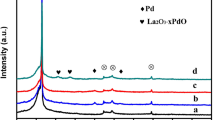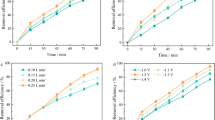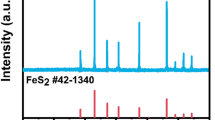Abstract
1-(2-chlorophenyl) ethanol (CPE) is of health and environmental concern due to its toxicity and its use as an intermediate in pharmaceutical manufacturing. The current work deals with the catalytic reductive dechlorination and detoxification of CPE by Pd/Fe bimetal. CPE was effectively dechlorinated to 1-phenyl ethanol (PE) accompanied by the equivalent release of chloride. The extent of CPE dechlorination increased with temperature, Fe dosage and Pd loading. A decrease in solution pH increased CPE dechlorination, resulting presumably from an increase in hydrogen production. Under the specific conditions of 20 g/L Pd/Fe, 0.10% Pd (w/w) and initial pH 5–6, the CPE dechlorination was completed within 145 min. The dechlorination followed a pseudo-first-order kinetics with an activation energy of 56.7 kJ/mol. The results of toxicity testing showed that CPE was very toxic to Chlorella, whereas PE showed little toxicity. The toxicity of the reaction solution declined gradually and the promoting effects on Chlorella intensified consequently with the dechlorination process. Thus, the reductive dechlorination of CPE to PE by Pd/Fe was a detoxification process. It may be used to effectively reduce the toxicological effects of CPE-contaminated wastewater, thereby enhancing the performance of subsequent biological processes in wastewater treatment.
Similar content being viewed by others
References
Abdel-Rahman, M.H.M., Ali, R.M., Said, H.A., 2004. The interactive effects of NaCl and ascorbic acid or KNO3 on growth and some related physiological activities of Chlorella vulgaris and Chlorococcum humicola. Egyptian Journal of Biotechnology, 18:233–250.
Aikawa, B., Burk, R.C., Sithole, B.B., 2003. Catalytic hydrodechlorination of 1-chlorooctadecane, 9, 10-dichlorostearic acid and 12,14-dichlorodehydroabietic acid in supercritical carbon dioxide. Applied Catalysis B Environmental, 43(4):371–387. [doi:10.1016/S0926-3373(03)00002-X]
Arnold, W.A., Roberts, A.L., 2000. Pathways and kinetics of chlorinated ethylene and chlorinated acetylene reaction with Fe(0) particles. Environmental Science & Technology, 34(9):1794–1805. [doi:10.1021/es990884q]
Choi, J.H., Kim, Y.H., Choi, S.J., 2007. Reductive dechlorination and biodegradation of 2,4,6-trichlorophenol using sequential permeable reactive barriers: Laboratory studies. Chemosphere, 67(8):1551–1557. [doi:10.1016/j.chemosphere.2006.12.029]
Dombek, T., Dolan, E., Schultz, J., Klarup, D., 2001. Rapid reductive dechlorination of atrazine by zero-valent iron under acidic conditions. Environmental Pollution, 111(1):21–27. [doi:10.1016/S0269-7491(00)00033-6]
Doong, R.A., Lai, Y.J., 2005. Dechlorination of tetrachloroethylene by palladized iron in the presence of humic acid. Water Research, 39(11):2309–2318. [doi:10.1016/j.watres.2005.04.036]
Farrell, J., Kason, M., Melitas, N., 2003. Investigation of the long-term performance of zero-valent iron for reductive dechlorination of trichloroethylene. Environmental Science & Technology, 34(3):514–521. [doi:10.1021/es990716y]
He, F., Zhao, D., 2005. Preparation and characterization of a new class of starch stabilized bimetallic nanoparticles for degradation of chlorinated hydrocarbons in water. Environmental Science & Technology, 39(9):3314–3320. [doi:10.1021/es048743y]
Kim, G., Jeong, W.Y., Choe, S.H., 2008. Dechlorination of atrazine using zero-valent iron (Fe0) under neutral pH conditions. Journal of Hazardous Materials, 155(3): 502–506. [doi:10.1016/j.jhazmat.2007.11.092]
Kim, Y.H., Carraway, E.R., 2003. Dechlorination of chlorinated ethenes and acetylenes by palladized iron. Environmental Technology, 24(7):809–819. [doi:10.1080/09593330309385618]
Kouznetsova, I., Bayer, P., Ebert, M., Finkel, M., 2007. Modelling the long-term performance of zero-valent iron using a spatio-temporal approach for iron aging. Journal of Contaminant Hydrology, 90(1–2):58–80. [doi:10.1016/j.jconhyd.2006.09.014]
Liu, Z.Y., Wang, G.C., Zhou, B.C., 2008. Effect of iron on growth and lipid accumulation in Chlorella vulgaris. Bioresource Technology, 99(11):4717–4722. [doi:10.1016/j.biortech.2007.09.073]
Rousch, J.M., Sommerfeld, M.R., 1998. Liquid-gas partitioning of the gasoline oxygenate methyl tert-butyl ether (MTBE) under laboratory conditions and its effect on growth of selected algae. Archives of Environmental Contamination and Toxicology, 34(1):6–11. [doi:10.1007/s002449900279]
Shen, H., Zhou, P.J., 2002. Advance in the studies on effect of environmental organic pollutants on the algae growth. Acta Hydrobiologica Sinica, 26:529–535 (in Chinese).
Shin, H.Y., Singhal, N., Park, J.W., 2007. Regeneration of iron for trichloroethylene reduction by Shewanella alga BrY. Chemosphere, 68(6):1129–1134. [doi:10.1016/j.chemosphere.2007.01.059]
Xing, W., Huang, W.M., Li, D.H., Liu, Y.D., 2007. Effects of iron on growth, pigment content, photosystem II efficiency, and siderophores production of Microcystis aeruginosa and Microcystis wesenbergii. Current Microbiology, 55:94–98. [doi:10.1007/s00284-006-0470-2]
Xu, X.H., Zhou, H.Y., Wang, D.H., 2003. Catalytic dechlorination of chlorobenzene in water by Pd/Fe system. Chinese Chemical Letters, 14:700–703.
Yan, X., Guoxing, S., Yu, D., 2002. Effect of N, N-dimethyl formamide used as organic solvent on two species of green algae Chlorella. Bulletin of Environmental Contamination and Toxicology, 68(4):592–599. [doi:10.1007/s001280295]
Author information
Authors and Affiliations
Corresponding author
Additional information
Project (Nos. 20977085 and 20688702) supported by the National Natural Science Foundation of China
Rights and permissions
About this article
Cite this article
Zhou, Hy., Wang, Sc. & Sheng, G.D. Catalytic dechlorination and detoxification of 1-(2-chlorophenyl) ethanol by Pd/Fe. J. Zhejiang Univ. Sci. A 11, 356–362 (2010). https://doi.org/10.1631/jzus.A0900469
Received:
Accepted:
Published:
Issue Date:
DOI: https://doi.org/10.1631/jzus.A0900469
Keywords
- 1-(2-chlorophenyl) ethanol (CPE)
- Pd/Fe
- Catalytic reductive dechlorination
- Detoxification
- 1-phenyl ethanol (PE)




